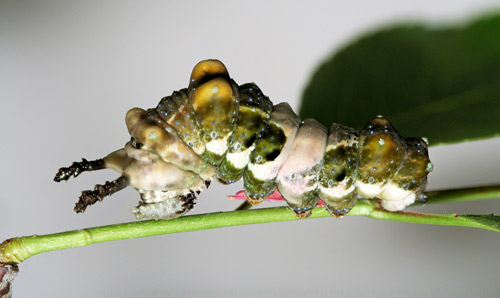Life Cycle
Male butterflies usually stay to themselves and seldom search for females to reproduce. Fertilized females lay eggs twice a year, once at the beginning of Spring and again towards the end of the Summer months (Weed, 1926). Eggs are laid singularly on the tips of leaves of various plants such as cherry trees, willow trees, apple trees and shrubs (Stout). Eggs are green in color and turn gray as the embryo develops. The surface of the eggs are covered with hexagons that have small spikes on them (Hall, 2013). It is thought that these spikes are used for protection against predators such as those listed on the Habitat page. These hair-like projections camouflage the eggs to mimic the hairs that cover the surface of leaves (Weed, 1926). Therefore when these predators come across the eggs they are more likely to pass by them instead of attack or eat them. It takes a few day to a week for the eggs to hatch once they are laid (Weed, 1926). The larvae go through three stages of development (Stout). During the third and final stage, the caterpillars have black heads and olive colored bodies with a white stripe across the middle. They hare about 1.6 inches long and are made to resemble bird droppings (Hall, 2013). This resemblance is used as a protection mechanism so that the larvae avoid being eaten.
The third stage larvae then either create a brownish-white pupa, also know as a chrysalis, or, if not fully developed, create a hibernaculum to hibernate inside throughout the harsh winter (Wagner, 2005). The While hibernating, the caterpillar's blood becomes thicker, its breathing slows, and the percent of water in its body decreases to reduce the risk of it freezing. The hibernaculum is made from a leaf that the caterpillar rolls itself into and uses silk to attach it to a twig (Wagner, 2005). Within a pupa is where the larva grows its wings and develops into a butterfly. The caterpillar hangs upside-down within the pupa for approximately 10 days, protected from the elements by the hardened outside of the pupa (Weed, 1926). The fully developed butterfly hatches out of the pupa and begins to fly after approximately 2-3 hours (Stout).
 Pupa Stage
Pupa StageThe upside of the Red-Spotted Purple Butterfly front wings are mainly blackish purple in color with a rows of white dots along the border (Hall, 2013). Orange dots can be seen on the tips of the wings and are fairly large in size (Hall, 2013). The hind wings are generally black but contain iridescent blue colored areas and white dots (Hall, 2013). The underside of the wings contain rows of blue iridescent patches over a blackish purple base (Hall, 2013). These iridescent spots contribute to the beautiful shimmer the butterfly gives off when in the sunlight (Weed, 1926). The underside also has rows of both orange and white dots(Hall, 2013). The wingspan ranges from 3.0 to 3.5 inches across (Hall, 2013). To view an image of this marvelous butterfly visit our Home and Adaptations pages.
